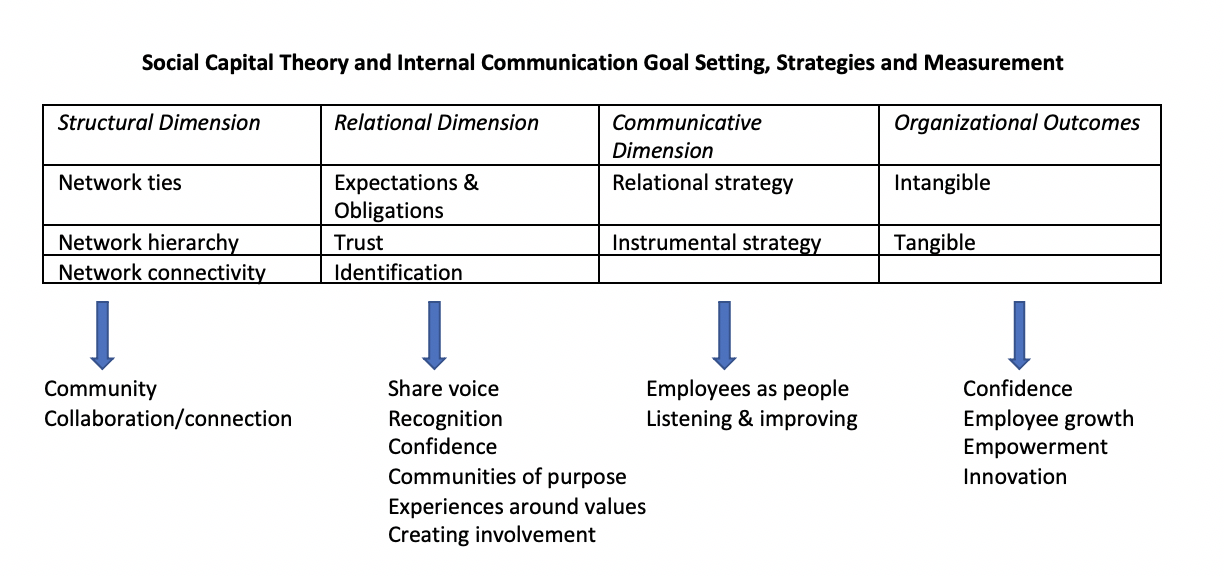This blog post is provided by the IPR Measurement Commission in celebration of Measurement Month in November.
Much of the focus in internal communication is on functional, pre-and post-test measurement and evaluation of campaign initiatives. While assessing outputs, outgrowths, and outcomes of communication campaigns and initiatives are both important and fundamental to practice, practitioners might consider more holistic approaches in order to better understand how internal communication creates value for employees and organizations (Buhmann, Likely & Geddes, 2018). For example, practitioners could more fully consider the social context of the organization as they endeavor to listen, learn, and discern insight from processes. Communicators could prioritize summative research in order to remain more agile as they respond to unforeseen situations (van Ruler, 2019). Practitioners could qualitatively measure how communication initiatives create intangible and tangible value, both for employees and organizations (Buhmann et al., 2018; Volk, 2016).
Michele Ewing and I examined how communicators working for large global companies identified intangible contributions of their internal communication work. Using social capital theory (Porters, 1998) as a framework, we qualitatively explored how internal communication builds and maintains employee relationships and creates social capital for the organization, which can be accrued and later expended for the organizational benefit (Kennan & Hazleton, 2006). Social capital refers to resources inherent within networks of relationships, which are facilitated by communication (Dodd, 2015).
Method
We conducted in-depth interviews among 27 practitioners and thought leaders who have an average of 15 years of internal communication experience and work for large, global companies representing diverse industries. After reading transcripts, we inductively identified how corporate communicators use internal communication to listen to employees and to create and maintain social capital.
Results
What objectives do internal communication practitioners have for internal social media?
Corporate communicators explained a range of objectives and strategies that they use to inform their internal communication efforts and tools, including both social and traditional. In addition to the common objective to create awareness and understanding of the organization, its strategy and direction, communicators also talked about ways they sought to create intangible value through their internal communication:
— Contribute to company culture
— Build community
— Create employee confidence
— Create collaboration and connection among employees and leaders
— Encourage employees to share their voices
— Recognize employees
What strategies do practitioners use to create an engaged workplace, using both internal social media and other channels?
In addition to common strategies such as effective storytelling, helping employees to understand the mission, vision, and values of the company, and customizing information, communicators spoke of these strategies:
— Fostering communities of purpose (e.g. “like identity communities, the LGBTQ community”)
— Treating employees as people
— Providing opportunities for employees to become involved (e.g. “From a global employee communication
standpoint, we try to focus on how do we activate around the differentiators for our culture.”)
— Creating experiences around organizational values (e.g. “Create experiences, whether recognition or communication events or do leadership training or any of those things that would bring that to life or make that a tangible experience someone can have with that particular value.”)
— Helping employees enjoy their jobs
— Listening and improving
RQ3: How do internal communication practitioners measure employee engagement?
Practitioners discussed many functional measurement and evaluation tactics (e.g. KPIs, engagement surveys, readership numbers, channel studies, digital analytics), but equally important and insightful were the more intangible measures. Communicators described that they examined employees’:
— Confidence in the company’s direction, strategy, and leadership
— Employees’ personal and professional growth (e.g. “Are employees leaving richer, not just financially?”)
— Employee empowerment
— Employees’ motivation to innovate (e.g. “What is the velocity of innovation? That is the signal that you’ve got an engaged workforce)
Implications
This research transcends formulaic, functional views of measurement and evaluation by describing how communication can help to create value for their organizations by building and maintaining social capital. Practitioners explained a range of objectives and strategies and evaluation tools to inform their internal communication that ultimately creates and maintains social capital: helping to build culture, creating communities of purpose, engendering confidence among employees and leadership, enabling collaboration among employees and leaders, encouraging employees to share their voice, among others. Public relations practitioners can ultimately use social capital in order to achieve organizational goals, such as enhanced recruitment, employee loyalty and retention, increased efficiency, innovation, and profitability.
References
Buhmann, A, Likely, F. & Geddes, D. (2018). Communication evaluation and measurement: Connecting research to practice. Journal of Communication Management, 22(1), 113-119.
Dodd, M. (2016). Intangible resource management. Social capital theory development for public relations. Journal of Communication Management, 20(4), 289-311.
Kennan, W.R. & Hazleton, V. (2006). Internal public relations, social capital, and the role of effective organizational communication. In C.H. Botan & V. Hazleton (Eds.), Public relations theory (pp. 311-335). Lawrence Erlbaum Associates, Mahwah, NJ.
Porters, A. (1998). Social capital: Its origins and applications in modern sociology. Annual Review of Sociology, 24(1), 1–24.
van Ruler, B. (2019). Agile communication evaluation and measurement. Journal of Communication Management, 23(3), 265-280. doi:http://dx.doi.org/10.1108/JCOM-12-2018-0136
Volk, S.C. (2016). A systematic review of 40 years of public relations evaluation and measurement research: Looking into the past, the present, and future. Public Relations Review, 42(5), 962-977.
Julie O’Neil, Ph.D., APR, is a professor in strategic communication and 
Thanks to Michele Ewing, M.S., APR and Rita Men, Ph.D. and for their contributions to this work.





